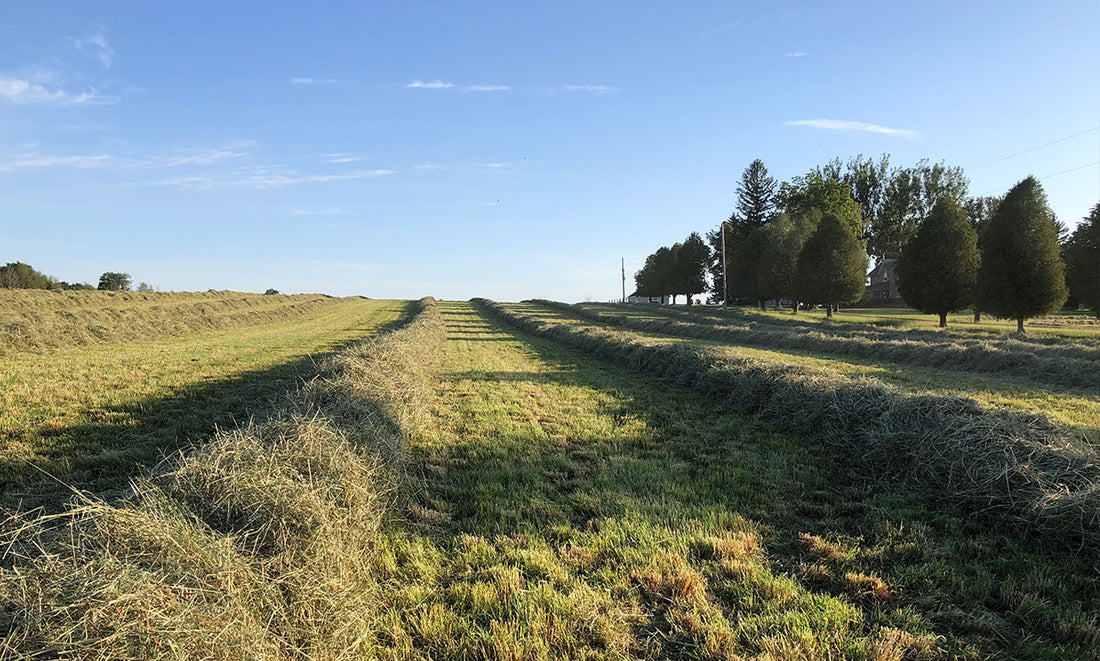
Experimental Acres – Our Lavender Hypothesis
We love experimenting. It’s fun to try new ways of doing things, and the honest truth is that I love challenging the status quo.
But there is risk in testing theories in the real world. Especially when it comes to theories that require a big financial investment and/or time. That’s why we’re super grateful for the support of Wellington County’s Experimental Acres program.
Our farm is joining 10 others in Wellington County to trial new, regenerative agriculture practices this year. For our project, we’re testing tarping as a no-till preparation for lavender field expansion.
When we planted our first plot of lavender in 2020, we plowed the field and then used a machine to mound and lay ground cover. This is how most lavender farms in Ontario prepare their fields. But there are environmental issues with plowing land - it releases greenhouse gases, disturbs the soil structure and harms the microbes living within healthy soil. So, we want to try a different approach.
The Plan
This summer we are laying the “ground work” to double our lavender plot size and plant 3,000 lavender plants in 2024.
The new lavender plot will be planted in a field that has been growing hay for many years. Before we can plant the lavender, the hay plants need to be killed off. Hay is a difficult crop to “break”. Most farms either plow their hay fields or spray with herbicide, but due to the small size of our expansion plot (1 acre), we can pursue alternative methods.
Our plan is to tarp the new field with weed barrier fabric a year prior to planting.
For the “tarp” we are using a breathable plastic fabric. This fabric is used by most lavender farms in Ontario as it reduces the number of weeds around lavender plants. It saves time, labour and avoids the use of herbicides. It blocks the sun and holds down any weeds that germinate, but it also allows water through. Typically, lavender farms work the soil, lay the weed barrier fabric and then plant into holes burned within the fabric. This is all done within a few days.
But we’re going to wait a whole year before planting.
The Hypothesis
Over the summer months, the plastic fabric should essentially “steam” the hay plants, killing them off naturally. The plants and their roots will decompose, and release nutrients back into the soil.
By June 2024 we should be able to plant with limited weeds and hay popping up around our new lavender plants. Fingers crossed!
By covering with weed barrier fabric for a yearlong cycle, we hope to:
- Reduce greenhouse gas emissions (by using no-till or low-till preparation)
- Preserve soil structure (through the root systems created by the hay)
- Avoid the use of herbicides
- Avoid compaction that occurs when plowing with a tractor
- Utilize the hay crop as a natural fertilizer
Preserving soil structure is incredibly important for us since we grow lavender on clay-loam soil, which typically doesn’t drain super well. Hay roots are large and create great paths for water to penetrate and move through the soil.
To track all of this, we will do soil tests before and after, monitor visually and keep records. We also have plans to do a couple of different “treatments” so we have areas and methods to compare.
Next up, covering nearly an acre of land with weed barrier fabric - wish us luck!
Xo, Stephanie
